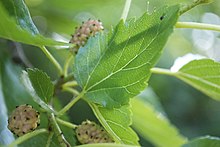Red mulberry
| Red mulberry | ||||||||||||
|---|---|---|---|---|---|---|---|---|---|---|---|---|

Red mulberry bark ( Morus rubra ) |
||||||||||||
| Systematics | ||||||||||||
|
||||||||||||
| Scientific name | ||||||||||||
| More rubra | ||||||||||||
| L. |
The red mulberry ( Morus rubra ) is a deciduous deciduous tree from the mulberry genus in the mulberry family ( Moraceae ). This species of plant is native to eastern North America .
description
The red mulberry grows as a deciduous tree and reaches heights of 10 to 15 meters, in preferred locations up to 20 meters. The gray-brown bark of the trunk breaks into long vertical strips with age. The alternate leaves reach a length of 7 to 14 cm and a width of 8 to 12 cm. Stipules are present. The leaves are quite variable in shape; Most of the leaves are broadly heart-shaped to ovate, but there are also two- and triple-lobed leaves. The leaf margin is roughly serrated. The autumn color is yellow.
The red mulberry is dioeciously dioecious , but there are also monoecious specimens that bear male and female flowers at the same time. The flowering period is from April to May. The flowers sit in pendulous cat-shaped inflorescences . The male inflorescences are 3 to 5 cm long; the females are 8 to 12 mm long and 5 to 7 mm wide. The green, small flowers are four-fold. The male flowers contain four fused bracts and four stamens . The female flowers contain four intergrown bracts and an upper, green ovary . The pollen is transmitted by the wind ( anemophilia ).
The cylindrical fruit associations are 2 to 3 cm long; they ripen in summer and change their color from green to red to dark purple. Each individual fruit contains a core, which is the actual fruit - a nut . The fruits are tasty and edible.
The number of chromosomes is 2n = 28.
distribution
The red mulberry is originally native to eastern North America. There the distribution area extends from southern Ontario and Vermont to Florida , in the west to southeastern South Dakota and central Texas .
The red mulberry prefers locations with moist soils. It is often found on rivers. It occurs at altitudes up to about 600 m.
In Europe, the red mulberry is rarely found outside of the botanical gardens.
The red mulberry is / was very common in the Balkans, Romania and Hungary until the mid-1980s. The country roads were lined with mulberry trees. The leaves were picked as fodder for sericulture.
ecology
The fruits of the red mulberry are mainly used by birds , but also mammals such as possums , raccoons and squirrels as food.
The leaves are nourished by many insects, including Parthenolecanium corni , Pseudococcus comstocki, and Pulvinaria innumerabilis .
Diseases and pests
The leaves of the red mulberry can be attacked by the fungi Mycosphaerella mori and Pseudomonas mori .
Branch and trunk wood are attacked by Pseudaulacaspis pentagona (mulberry scale insect ), Euzophera semifuneralis and Doraschema wildii .
Systematics
The first description by the Swedish botanist Carl von Linné was published in 1753. In North America, the red mulberry often hybridizes with the white mulberry ( Morus alba ) imported from Eurasia .
use
The fruits of the red mulberry are eaten or used for jams, fruit cakes and for making juice. The fruits are very sweet. The mulberry brandy is also a specialty. The fruits can be eaten raw or, for example, added to yogurt. If the fruits are to be used as food, the ripe fruits are shaken off into clean towels. The wood can be described as hardwood and has a beautiful golden yellow color; therefore it is also popular for barrel production. In the case of the wine barrel and schnapps barrel, the wood gives off its golden color to the alcohol. Because of its golden yellow color, the wood is also popular with furniture makers and cabinet makers.
Individual evidence
- ↑ More rubra at Tropicos.org. In: IPCN Chromosome Reports . Missouri Botanical Garden, St. Louis
- ↑ Sp. Pl. 2: 986. 1753. See entry in GRIN Taxonomy for Plants .
literature
- C. Frank Brockman: Trees of North America . St. Martin's Press, New York 2001, ISBN 978-1-58238-092-6 .
- Reinhard Lieberei, Christoph Reisdorff: Crop science - founded by Wolfgang Franke. 7th edition. Thieme-Verlag, Stuttgart 2007, ISBN 978-3-13-530407-6 , p. 212 f.
Web links
- Thomas Meyer: Data sheet with identification key and photos at Flora-de: Flora von Deutschland (old name of the website: Flowers in Swabia )
- Description in the Flora of North America. (English)
- Description at na.fs.fed.us (English)
- Specifications at VirginiaTech (English)
- Entry at USDA (English)
- Pictures at duke.edu (English)


